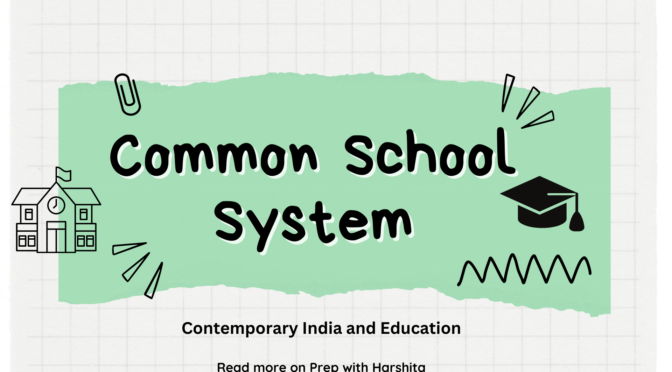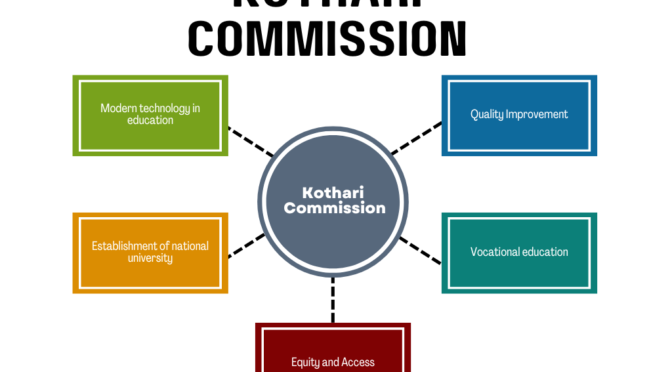The Common School System in Indian education refers to a proposed educational framework that aims to provide equal and quality education to all children, irrespective of their socio-economic background. While the Common School System has not been fully implemented nationwide in India, the concept has been discussed and debated as a means to address educational disparities and ensure universal access to education.
Here are some key details about the Common School System in Indian education:
- Equity and Access: The Common School System focuses on achieving equity in education by ensuring that every child, regardless of their social or economic background, has equal access to quality education. It aims to eliminate disparities between government schools and private schools, rural and urban areas, and different socio-economic strata.
- Compulsory and Free Education: The Common School System emphasizes the provision of free and compulsory education for all children between the ages of 6 and 14, as mandated by the Right to Education (RTE) Act in India. It aims to remove barriers to education by ensuring that parents are not burdened with the cost of schooling.
- Common Curriculum: Under the Common School System, there is an emphasis on a common curriculum for all schools, focusing on a well-rounded education. The curriculum typically includes core subjects such as languages, mathematics, science, social sciences, and vocational skills. It aims to provide a balanced education that promotes holistic development.
- Quality Standards: It promotes the establishment of quality standards for all schools, whether they are government-run or private. These standards encompass infrastructure, teaching-learning materials, teacher qualifications, student-teacher ratios, and other parameters. The goal is to ensure that every school meets the prescribed standards of quality education.
- Inclusive Education: In line with the principles of inclusive education, It seeks to provide equal opportunities for children with disabilities and special needs. It emphasizes the need for appropriate infrastructure, support services, and trained educators to cater to the diverse needs of all learners.
- Teacher Training and Professional Development: It recognizes the crucial role of teachers in delivering quality education. It emphasizes the need for teacher training programs to enhance teaching skills and pedagogical techniques. Ongoing professional development opportunities are encouraged to keep educators updated with the latest teaching methodologies and practices.
- Public Funding and Governance: The successful implementation of the this System requires adequate public funding for education. It involves increased government expenditure to ensure that schools have sufficient resources, infrastructure, and well-trained teachers. The system also emphasizes transparent governance, accountability, and monitoring mechanisms to maintain the quality of education.
- Community Participation: The Common School System encourages active community participation in the education system. It promotes the involvement of parents, local communities, and stakeholders in school management committees, decision-making processes, and monitoring the functioning of schools.
Introduction of Common School System in India:
The concept of the Common School in India was first introduced by the Kothari Commission, also known as the Education Commission, in 1964-1966. The Kothari Commission was a landmark committee appointed by the Government of India to examine the state of education in the country and recommend reforms.
Under the leadership of renowned educationist Daulat Singh Kothari, the commission submitted its report titled “Education and National Development” in 1966. The report proposed several comprehensive reforms in the education sector, including the concept of a Common School System.
The Kothari Commission recommended the establishment of a uniform and common educational structure that would provide free and compulsory education for all children up to a certain age. It advocated for a common curriculum and emphasized the need to bridge the gap between rural and urban education, as well as the disparity between different socio-economic groups.
The commission highlighted the importance of equality of educational opportunities and the need to eliminate the prevailing disparities in access to quality education. The Common School System was seen as a means to achieve this goal by ensuring that every child, regardless of their background, could receive an equitable and quality education.
While the Kothari Commission’s recommendations were not implemented in their entirety, they had a significant influence on shaping education policies in India. The concept of the Common School System continues to be discussed and debated as a means to achieve universal and equitable education in the country.
Also Visit: Prep with Harshita

Also Read: Concurrent Status of Education



